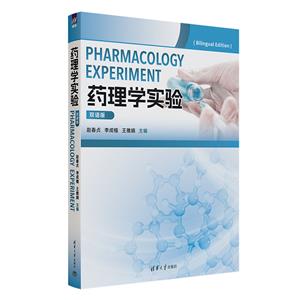药理学实验(双语版) 版权信息
- ISBN:9787302676225
- 条形码:9787302676225 ; 978-7-302-67622-5
- 装帧:平装-胶订
- 册数:暂无
- 重量:暂无
- 所属分类:>>
药理学实验(双语版) 本书特色
《药理学实验》(双语版)的特色之一是通过数字技术将实验操作中的难点和难点演示视频、知识拓展素材与纸质媒体融合,有效提升了教材的知识容量,又与现代学生的学习方式契合,适用于全国高等医学药学院校医学、药学专业以及相关专业学生使用。可供医学院校护理学专业教学使用,也可供医护相关行业人员参考使用。
药理学实验(双语版) 内容简介
《药理学实验》(双语版)为全国普通高等医学药学院校医药学专业的《药理学》课程配套实验教材。全书分为六个模块:药理学总论、传出神经系统药理、中枢神经系统药理、心血管系统药理、激素内脏药理、化疗药物药理。围绕国内高校广泛开设的药理学经典教学实验,深入探讨和解释实验理论、技术、现象等方面的问题,并将相关知识领域的前沿拓展融入其中。同时每个实验配套练习题、思考题和与实验相关的课程思政素材,《药理学实验》(双语版)兼具实验指导和实践育人双重功能。《药理学实验》(双语版)的特色之一是还通过数字技术将实验操作中的难点和难点演示视频、知识拓展素材与纸质媒体融合,有效提升了教材的知识容量,又与现代学生的学习方式契合。《药理学实验》(双语版)适用于全国高等医学药学院校医学、药学专业以及相关专业学生使用。《药理学实验》(双语版)供医学院校护理学专业教学使用,也可供医护相关行业人员参考使用。
药理学实验(双语版) 目录
**章 药理学总论 1**节 实验动物的基础知识 1第二节 实验动物的常用技术 4第三节 实验动物伦理 11第四节 磺胺嘧啶血浆半衰期的测定 13第五节 普鲁卡因半数致死量测定 17第六节 肝功能对药物作用的影响 21第七节 不同剂量对药物作用的影响 24第八节 不同给药途径对硫酸镁作用的影响 28第九节 药物体外IC50的测定 31第二章 传出神经系统药理 35**节 乙酰胆碱的量效关系实验 35第二节 传出神经系统药物对离体肠管平滑肌的作用 38第三节 传出神经药物对家兔瞳孔的影响 41**章 药理学总论 1**节 实验动物的基础知识 1第二节 实验动物的常用技术 4第三节 实验动物伦理 11第四节 磺胺嘧啶血浆半衰期的测定 13第五节 普鲁卡因半数致死量测定 17第六节 肝功能对药物作用的影响 21第七节 不同剂量对药物作用的影响 24第八节 不同给药途径对硫酸镁作用的影响 28第九节 药物体外IC50的测定 31第二章 传出神经系统药理 35**节 乙酰胆碱的量效关系实验 35第二节 传出神经系统药物对离体肠管平滑肌的作用 38第三节 传出神经药物对家兔瞳孔的影响 41第四节 阿托品对小鼠平滑肌的抑制作用 45第五节 有机磷农药的中毒及解救 49第三章 中枢神经系统药理 53**节 药物的镇痛作用实验 53第二节 氯丙嗪对电刺激小鼠激怒反应的影响 56第三节 阿司匹林与氯丙嗪对体温的影响 59第四节 泮库溴铵和琥珀胆碱对家兔肌松作用的比较 63第五节 苯巴比妥钠的抗惊厥作用 67第六节 药物抗尼可刹米惊厥的作用 71第七节 地西泮的抗焦虑作用 75第八节 尼可刹米对吗啡呼吸抑制的解救作用 78第九节 普鲁卡因的局部作用及全身作用 82第四章 心血管系统药理 86**节 传出神经系统药物对家兔血压的影响 86第二节 利多卡因对抗电刺激诱发心律失常的作用 90第三节 抗心律失常药物对氯化钡诱导心律失常的治疗作用 93第四节 强心苷对离体蛙心舒缩作用的影响 96第五节 普萘洛尔对小鼠缺氧耐受力的影响 99第五章 激素内脏药理 103**节 硫酸鱼精蛋白对肝素抗凝活性的拮抗作用 103第二节 胰岛素的过量反应及解救 106第三节 阿司匹林拮抗血栓形成的作用 109第四节 缩宫素对豚鼠离体子宫平滑肌的作用 113第五节 利尿药对动物尿量的影响 116第六节 氢化可的松对二甲苯所致小鼠耳郭肿胀的影响 119第七节 硫酸镁、生大黄对小鼠肠管推进作用的影响 122第八节 药物对小鼠凝血时间的影响 126第九节 喷托维林的镇咳作用观察 129第六章 化疗药物药理 133**节 链霉素的毒性反应及解救 133第二节 头孢拉定血药浓度的检测 135第三节 注射剂的溶血实验 139第四节 注射剂的热原检查 142第五节 多柔比星体外抑制肿瘤细胞生长的作用 146第六节 青霉素G的体外抗菌作用 149第七章 实验设计 154**节 实验设计的目的和意义 154第二节 实验设计的基本要素与原则 155第三节 实验设计的基本内容与方法 158第四节 实验设计的类型 160第五节 实验设计的步骤与要求 161第八章 案例分析 163案例1 163案例2 163案例3 164案例4 165第九章 常用实验仪器设备 166**节 信息化集成化信号采集与处理系统 166第二节 分光光度计 170第三节 生理、药理电子刺激仪 172附 录 176附录1 药理实验中药物的浓度及剂量换算 176附录2 常用生理溶液的成分和配置 178附录3 药物的剂型及处方 179附录4 实验报告的撰写 182附录5 练习题参考答案 184
Chapter 1 General pharmacology 187Section 1?Basic knowledge of experimental animals 187Section 2?Common techniques for experimental animals 192Section 3?Ethics of experimental animals 202Section 4?Determination of plasma half life of sulfadiazine 204Section 5?Determination of LD50 of procaine 210Section 6?The influence of liver function on drug action 215Section 7?Effects of different dosage on drug action 220Section 8?Effects of different administration routes on the action of magnesium sulfate 224Section 9?Determination of IC50 of drugs in vitro 228Chapter 2 Pharmacology of efferent nervous system 234Section 1?Dose-effect relationship of acetylcholine 234Section 2?The effect of efferent nervous system drugs on isolated intestinal smooth muscle 238Section 3?The effect of efferent nervous system drugs on the pupil of rabbits 243Section 4?Inhibition of atropine on smooth muscle in mice 247Section 5?Poisoning and rescue of organophosphorus pesticides 253Chapter 3 Central nervous system pharmacology 258Section 1?Analgesia experiment of drugs 258Section 2?The effect of chlorpromazine on electric stimulation-induced agitation in mice 263Section 3?Effects of aspirin and chlorpromazine on body temperature 266Section 4?Comparison of the effects of pancuronium bromide and succinylcholine on muscle relaxation in rabbits 272Section 5?Anticonvulsant effect of phenobarbital sodium in mice 276Section 6?The effect of drugs on resisting nikethamide-induced convulsions 282Section 7?Anxiolytic effects of diazepam 287Section 8?Rescue effect of nikethamide on morphine induced respiratory depression 292Section 9?Local and systemic effects of procaine 296Chapter 4 Cardiovascular system pharmacology 301Section 1?Effect of efferent nervous system drugs on blood pressure in rabbits 301Section 2?The effect of lidocaine on arrhythmia induced by electrical stimulation 307Section 3?The therapeutic effect of antiarrhythmic drugs on BaCl2-induced arrhythmia 310Section 4?The effect of cardiac glycosides on the relaxation and contraction of detached frog hearts 314Section 5?Effects of propranolol on hypoxia tolerance in mice 319Chapter 5 Hormonal visceral pharmacology 324Section 1?Antagonistic effect of protamine sulfate on heparin anticoagulant activity 324Section 2?Reaction and rescue of insulin overdose 328Section 3?The antagonistic effect of aspirin on thrombosis formation 332Section 4?The effect of oxytocin on uterine smooth muscle in vitro in guinea pigs 337Section 5?The effect of diuretics on animal urine output 341Section 6?The effect of hydrocortisone on ear swelling induced by paraxylene in mice 345Section 7?Effects of magnesium sulfate and raw rhubarb on intestinal propulsion in mice 350Section 8?The effect of drugs on coagulation time in mice 354Section 9?Observation of antitussive effect of pentoverine 359Chapter 6 Pharmacology of chemotherapy drugs 364Section 1?Toxic reactions of streptomycin and its relief 364Section 2?Determination of blood concentration of cefradine 367Section 3?Hemolysis test of injection 371Section 4?Pyrogen examination of injection 376Section 5?The inhibitory effect of doxorubicin on tumor cell growth in vitro 381Section 6?The in vitro antibacterial effect of penicillin G 385Chapter 7 Experimental design 392Section 1?The objective and significance of experimental design 392Section 2?The basic elements and principles of experimental design 393Section 3?The main content and method of experimental design 398Section 4?Types of experimental design 400Section 5?The procedure and requirement of experimental design 402Chapter 8 Case analysis 405Case 1 405Case 2 406Case 3 407Case 4 407Chapter 9 Common experimental instruments 409Section 1?Information integrated signal acquisition and processing system 409Section 2?Spectrophotometer 414Section 3?Physiological and pharmacological electronic stimulators 417Appendix 422Appendix 1?Conversion of drug concentration and dosage in pharmacological experiments 422Appendix 2?Composition and preparation of common physiological solutions 425Appendix 3?Drug dosage form and prescription 426Appendix 4?Experimental report writing 430
展开全部
药理学实验(双语版) 作者简介
赵春贞:副教授、硕士研究生导师。山乐约理学会教学与科普专业委员会副主任委员、中国药理学会教学与科普专业委员会委员、山东药理学会理事、山东毒理学会理事。山东省研究生优质课程负责人、中国医药研究生在线课程群建设项目负责人。主持、参与国家自然科学基金项目4项,发表SCI收录论文20余篇。主编、参编教材7部。授权国家发明专利3项。李成檀:副教授、硕士研究生导师,浙江省高校优秀青年教师资助计划人选。从事药理学教学16年,主讲药理学、药理学实验等课程。参编《药理学》《临床药理学》等教材、专著5部,获浙江省教学成果二等奖,主持、参与各级教学改革项目、科研项目10余项,在Ageing Res Rev、Neurobiol Aging等期刊发表论文20余篇。王雅娟:副教授、硕士研究生导师。任中国药理学会抗炎免疫药理学分会青年委员、安徽省药理学会抗炎免疫药理学专业委员会第一届委员会委员。从事教学工作近二十年,承担《药理学》临床药理学》《实验动物学》等课程的教学及相关科研工作。主持并参与了多项国家级、省级教研和科研项目,参与安徽省高等学校一流教材《护理药理学》的编写工作。





















